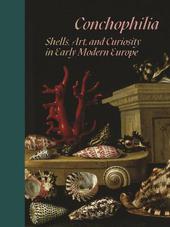
|
Conchophilia: Shells, Art, and Curiosity in Early Modern Europe
Hardback
Main Details
| Title |
Conchophilia: Shells, Art, and Curiosity in Early Modern Europe
|
| Authors and Contributors |
By (author) Marisa Anne Bass
|
|
By (author) Anne Goldgar
|
|
By (author) Hanneke Grootenboer
|
|
By (author) Claudia Swan
|
|
Contributions by Stephanie S. Dickey
|
| Physical Properties |
| Format:Hardback | | Pages:224 | | Dimensions(mm): Height 254,Width 191 |
|
| Category/Genre | Art History
History of science |
|---|
| ISBN/Barcode |
9780691215761
|
| Classifications | Dewey:594 |
|---|
| Audience | |
|---|
| Illustrations |
85 color illus.
|
|
Publishing Details |
| Publisher |
Princeton University Press
|
| Imprint |
Princeton University Press
|
| Publication Date |
17 August 2021 |
| Publication Country |
United States
|
Description
Among nature's most artful creations, shells have long inspired the curiosity and passion of artisans, artists, collectors, and thinkers. Conchophilia delves into the intimate relationship between shells and people, offering an unprecedented account of the early modern era, when the influx of exotic shells to Europe fuelled their study and representation as never before. From elaborate nautilus cups and shell-encrusted grottoes to delicate miniatures, this richly illustrated book reveals how the love of shells intersected not only with the rise of natural history and global trade but also with philosophical inquiry, issues of race and gender, and the ascent of art-historical connoisseurship. Shells circulated at the nexus of commerce and intellectual pursuit, suggesting new ways of thinking about relationships between Europe and the rest of the world. The authors focus on northern Europe, where the interest and trade in shells had its greatest impact on the visual arts. They consider how shells were perceived as exotic objects, the role of shells in courtly collections, their place in still-life tableaus, and the connections between their forms and those of the human body. They examine how artists gilded, carved, etched, and inked shells to evoke the permeable boundary between art and nature. These interactions with shells shaped the ways that early modern individuals perceived their relation to the natural world, and their endeavours in art and the acquisition of knowledge. Spanning painting and print to architecture and the decorative arts, Conchophilia uncovers the fascinating ways that shells were circulated, depicted, collected, and valued during a time of remarkable global change. 'A truly fascinating book with broad interdisciplinary appeal. Conchophilia is well researched, and filled with remarkable visual material, rich descriptions, and new insights.' - Angela Vanhaelen, author of The Wake of Iconoclasm 'Important and potentially field-defining, Conchophilia convincingly argues for the aesthetic, philosophical, and social importance of exotic shells in early modern culture. The work's interdisciplinary nature combined with the sheer mass of dazzling illustrations will appeal to a wide audience as well as specialists in art history, the history of science, and the history of early modern Europe.' - Beth Tobin, author of The Duchess's Shells
Author Biography
Marisa Anne Bass is Professor of Northern European Art (1400-1700) at Yale University. Her books include Insect Artifice and Jan Gossart and the Invention of Netherlandish Antiquity (both Princeton). Anne Goldgar is the Garrett and Anne Van Hunnick Professor of European History at the University of Southern California. Her books include Tulipmania and Impolite Learning. Twitter @anne_goldgar Hanneke Grootenboer is Professor of the History of Art and Chair of the department at Radboud University Nijmegen. Her books include Treasuring the Gaze and The Pensive Image. Claudia Swan is the Mark S. Weil Professor of Art History and Archaeology at Washington University in St. Louis. Her books include Art, Science, and Witchcraft in Early Modern Holland and Rarities of These Lands (Princeton). Twitter @raritiesof
Reviews"In Conchophilia seven scholars dissect why Renaissance-era collectors braved maritime hazards to beachcomb. Finding the pearliest treasures at shorelines called for avoiding crocodiles, spiny urchins and 'burning sea slime'. . . . Painters depicted shells, with names as wonderful as 'precious wentletrap' and 'speckled episcopal miter,' arrayed on banquet tables or in the hands of exulting deities. Metalsmiths set nautiluses on gold pedestals sculpted with mermaid and sea foam motifs. Collectors had favorite shells cemented onto grotto walls, sometimes in the bristly shapes of pine cones and artichokes."---Eve M. Kahn, New York Times "This richly illustrated collection of essays conceptualises the shell and how it was used in material and visual culture, philosophy, and aesthetics as a 'vessel' to comprehend early modern society, primarily in a Dutch and German context. . . . [A] well-produced and beautiful book, even its softly glowing endpapers reminiscent of polished shells and nacre. Of interest to art historians, historians of science, and historians of visual and material culture, the essays are also clearly written and approachable, offering many pearls of wisdom. I highly recommend it."---Anna Marie Roos, Early Modern Low Countries "The exquisitely illustrated, thought-provoking book examines the complicated provenances, varied uses, and key role of shells in shaping this period's visual and aesthetic culture."---Lauren Moya Ford, Hyperallergic "[Conchophilia does] an excellent job in surveying both art history and the history of science to discuss the uses of shells in art. . . . The lavish illustrations alone are worth the price of purchase. . . . Truly a feast for the eyes."---Alan R. Kabat, American Conchologist "Conchophilia is well-designed and beautifully illustrated, a book that deploys wonderful narratives about the love of shells in early modern Europe. . . . A captivating combination of the material and the social, of shells and people."---Marlise Rijks, Early Science and Medicine
|